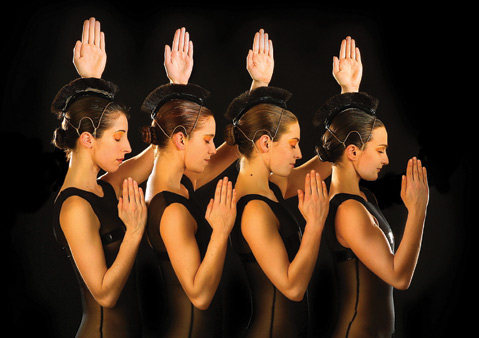Compagnie Marie Chouinard Makes S.B. Debut
The Granada Hosts Montreal-Based Dance Group

Choreographer Marie Chouinard doesn’t hold back. Thirty-five years after her solo “Crystallization” established her as a maker of fierce, unapologetically physical dances, Chouinard continues to take risks — and to surprise herself. “Making a new dance is an adventure into an unknown world,” the 57-year-old French-Canadian choreographer stated last month in her Montreal studio. This Friday, March 8, UCSB Arts & Lectures brings Compagnie Marie Chouinard to Santa Barbara for the first time. The company will perform two of her signature works: the provocative “24 Preludes by Chopin,” and Rite of Spring, an original and abstract dance set to the Stravinsky score that has inspired so many movement artists.
In advance of her company’s Granada appearance, the expressive Chouinard spoke about tackling challenges, and the process of discovering “the rhythms of the body.”
What made you choose to tackle Rite of Spring?
So many choreographers have revisited this score since Nijinsky’s original ballet, 100 years ago. I had been working on a version of “Afternoon of a Faun,” which of course Nijinsky also created, but as soon as I stepped into the universe of Rite of Spring, I was no longer interested in Nijinsky; I was only interested in Stravinsky. The music became the most essential thing. How does this music affect me on a cellular level — how does it affect my spinal cord? And what is inside the spinal cord — the intelligence of the biological being? There is a story that comes with the music, but I was not interested in that at all; it was the materiality of the music that attracted me, and also the multi-layered aspect of the music. The score has many instruments simultaneously performing different rhythms. All of that is very kinetically appealing for the body.
That reminds me of something you’ve said in the past, which is that your job is to tune in to a “mysterious wavelength.” Can you say more about that process?
I see rhythm not as something the body does to be on the musical beat — especially when the musical beat is a square one-two-three-four, one-two-three-four, which you don’t have anyway in the music of Stravinsky. For every new section of Rite of Spring, we have to find a different system of counting. But that’s fine, because right away we are dealing with an organic rhythm, rather than the rhythm of a pendulum. Stravinsky is creating music the way I feel rhythm in my body. Let’s speak about the rhythm of breathing. [She stops speaking and breathes erratically into the phone.] Is there a regular rhythm there? No, but you immediately recognize that there’s a human pattern. That’s the rhythm of life, and it’s there in the music of Stravinsky. In my movement, I’m much more interested in that kind of rhythm than anything mathematically regular.
You’re also working with the music of Chopin, which is much more regular, rhythmically speaking.
Yes, but at the same time what’s happening here with Chopin is that we have 24 preludes, each of them very short, and with their own flavor, their own spirit. Choreographically, it was extraordinary for me to go from one moment to another 24 times. Yes, it’s very different from the Stravinsky, but both scores are complex. At the time Chopin was composing, what he did was a very unusual thing; classical composers would not typically create tiny little bits of music of this kind. There’s usually just one prelude, not 24 in a row. This is radical, like writing 24 introductions to a novel, back to back.
Tell me about your creative process — where do you usually begin?
Choreographing to pre-existing music is atypical for me. I usually create movement first, and then the music comes after, as do costumes and light and set design. Often I have a deep interest in a little detail of movement, so I start there, and then I amplify this thing, search for it from different angles. With Rite of Spring, the detail that fascinated me was the undulation of the spine: How will the arm flow out of the undulation; how will the leg flow out? With “24 Preludes,” I kept returning to fluttering movements of the hands. It’s because of Chopin. He was a virtuoso with his hands, so if you connect yourself with the spirit of Chopin’s music, it comes out into your hands and wrists, as well as into your emotions.
Once you have established a movement theme, how do you involve your dancers?
For example, I will ask them to make a fluttering movement with their hands, and seeing them do it clarifies my original impulse. Then I’ll say, “No, no, I want it faster; yeah, yeah, now slower, and now with two hands.” So it’s from seeing my demand realized or not that I can give my second instruction to the dancer, and then my third. I don’t just create it all in my head. I guess it’s a lot like a painter: he throws some paint on the canvas, and then says, “Oh no, I need a much lighter yellow,” and once that’s there, he says, “I need a dark space up above and to the right,” and it’s only from seeing what emerges that he knows the next thing he wants to do. My process is similarly very concrete. I work with materials: space and time and the bodies there in front of me.
4•1•1
UCSB Arts & Lectures brings Compagnie Marie Chouinard to the Granada Theatre (1214 State St.) on Friday, March 8, at 8 p.m. For tickets, call (805) 893-3535 or visit artsandlectures.sa.ucsb.edu.



